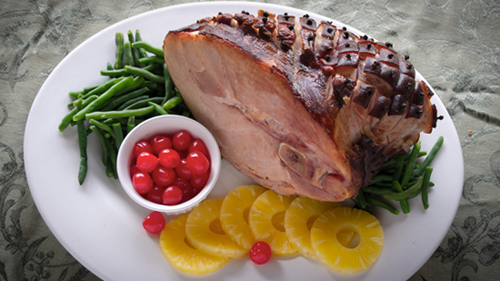Easter is a holiday with a host of food traditions. Hot Cross Buns, honeyed pastries, pretzels (folded in the shape of praying arms) and, of course, eggs, the edible symbol of rebirth. A traditional baked ham is a favorite at the center of the American Easter table. Roast lamb is also popular, but a glistening glazed ham studded with cloves is the first choice for Easter dinner.
When our forebears lived off the land and there was no refrigeration, food preservation was the only way to keep food for future consumption. Curing and smoking was the best way to keep pork that was slaughtered in the cool Fall. The leg, or ham, was the choice cut. Cured with salt and smoked over hardwood, it was preserved until spring when it was presented at the festive Easter table.
Cultures around the world all have their traditions for curing hams. It’s said that the Chinese were the first to cure ham. European countries are famous for their raw cured hams, Prosciutto de Parma, Serrano from Portugal and Black Forest from Germany all protected by local laws to insure authenticity. In America The Smithfield Ham or Country Ham follows this tradition, but for Easter we’re usually talking about a milder smoked ham.
The best smoked ham I’ve found comes from close-by Torrington, CT. Family-run Nodine’s Smokehouse has been smoking top quality pork since 1969. Ronald and his wife Johanne along with son Calvin select only the best pork for smoking according to their old-world recipe. The hams have an authentic smoked flavor and meaty texture not often found today.
I called Ron Nodine to ask him about his much-admired hams. He enthusiastically shared his deep knowledge of hams and love of the smoking process. “Start with the best pork,” he said. Nodine’s gets theirs from reliable suppliers all over the country who provide the quality they demand.
“Cure and smoke the old fashioned way.” Nodine brine-cures his hams for 10 days in a mixture of sugar, salt and nitrites (which give it the distinctive pink color). The 10-day cure allows the brine to penetrate the meat and flavor it all the way through. The unrushed brining process gives these hams their distinctive meaty texture.
“Smoke the hams for 15 to 18 hours.” This is where the smokehouse magic takes place. A mix of dried apple pomace (from cider making), hickory and hardwood sends up a fragrant smoke to flavor the hams. The length of time depends on variables including the outside temperature and humidity. The smokemaster knows from years of experience how much time is needed to get a distinctive but not overpowering just-right smoke flavor. Acrid smoke from corn cobs never touches a Nodine’s ham according to Ron.
I asked Ron about bone-in, boneless and spiral cut – the most often heard debate about what ham to buy. “Spiral cut is popular,” he said,”but be careful not to overcook.” The ham is ready to eat. All that is needed is to gently warm it to about 120 degrees. After that, the many spiral cuts can start to separate and dry out. Bone-in is more popular than boneless. “People like the presentation of a full ham carved off the bone”, he said. I’ll confess that I usually get the boneless ham. The bone-in is my favorite, but it’s a lot of ham. Nodine’s offers a party ham of about five pounds, which is just right for a nice dinner, some left overs, and a ham salad sandwich to finish it off.
Nodine’s also smokes hams from the heritage breed Berkshire hogs. This meat is richer and more fully marbled for more flavor. (Fat equals flavor!) Also known as Kurobuta in Japan, these hams are a growing slice of Nodine’s ham sales.
Nodine’s hams, like any hand-made artisanal product, are more costly than supermarket hams. They’re made by hand with top-quality ingredients and loving care. No shortcuts or mass production methods. The hams are not “water added” and actually weigh less after processing than when they started. They’re definitely worth it.
All hams are fully cooked (by law) and just need to be heated up. I cut off some of the outer fat and surface dried by smoking, score the top and stick in some cloves. The ham goes in at 325 for about 20 minutes per pound (a little less time is better than more) on a rack. For the last 15 minutes or so, I put the heat up to 400 and slather the ham with some fruit glaze, which melts and browns giving the ham a beautiful lustre. My favorite glaze is good apricot jam with some dry and whole grain mustards stirred in for zing. Thin the jam with some brandy or other liquor and spread it on. Make a lot, and the leftover glaze can be heated for a sauce.
Hams are the big sellers at Easter, but Nodine’s smokes over 100 items – a dazzling array of pork, poultry, seafood, cheese and sausages. Bacon, in its many enticing flavors, is the most popular item year round. Be sure to visit the Nodine’s Smokhouse web site at www.nodinesmokehouse.com to order your Easter ham and get a few more goodies too.











No Comment